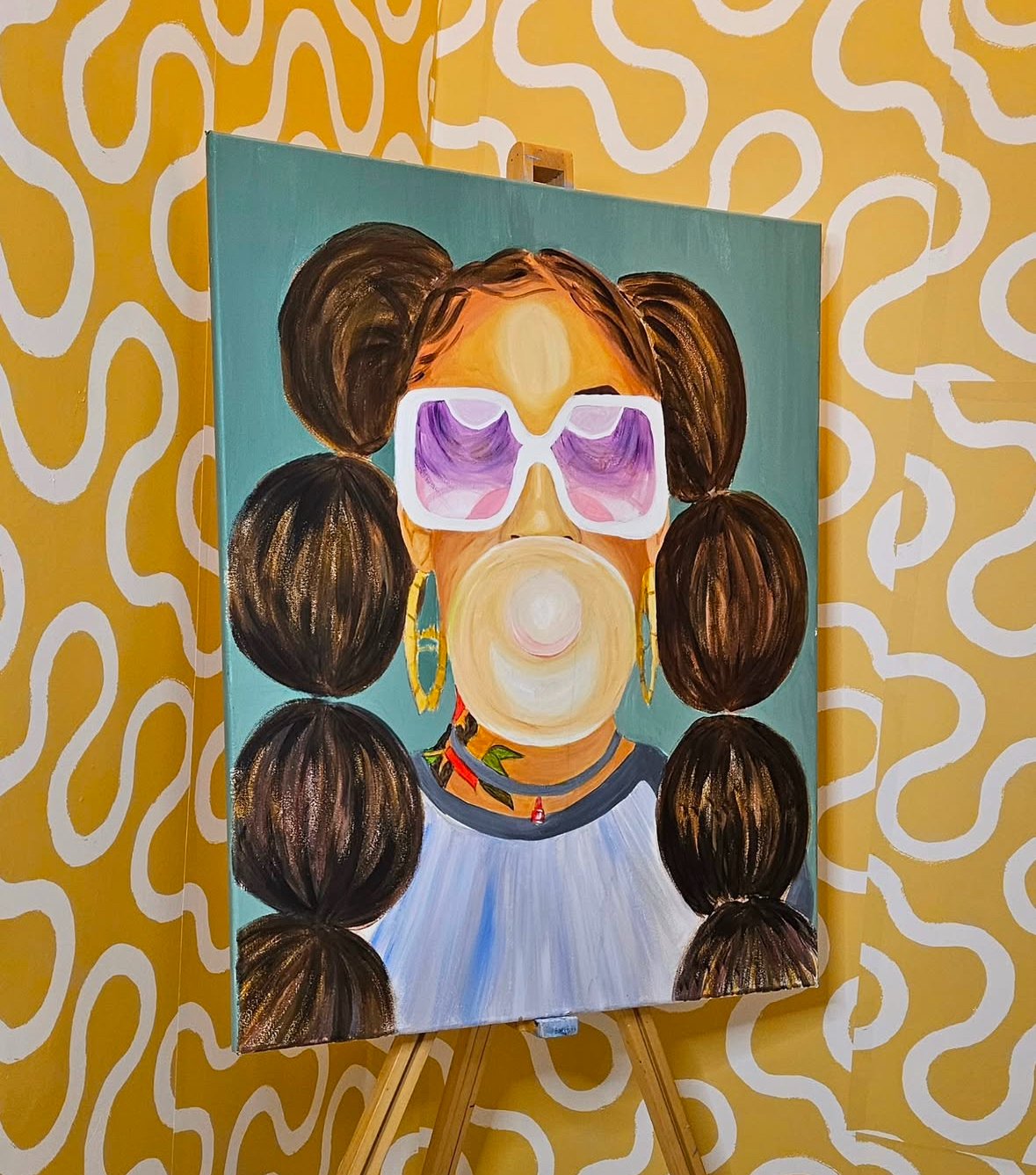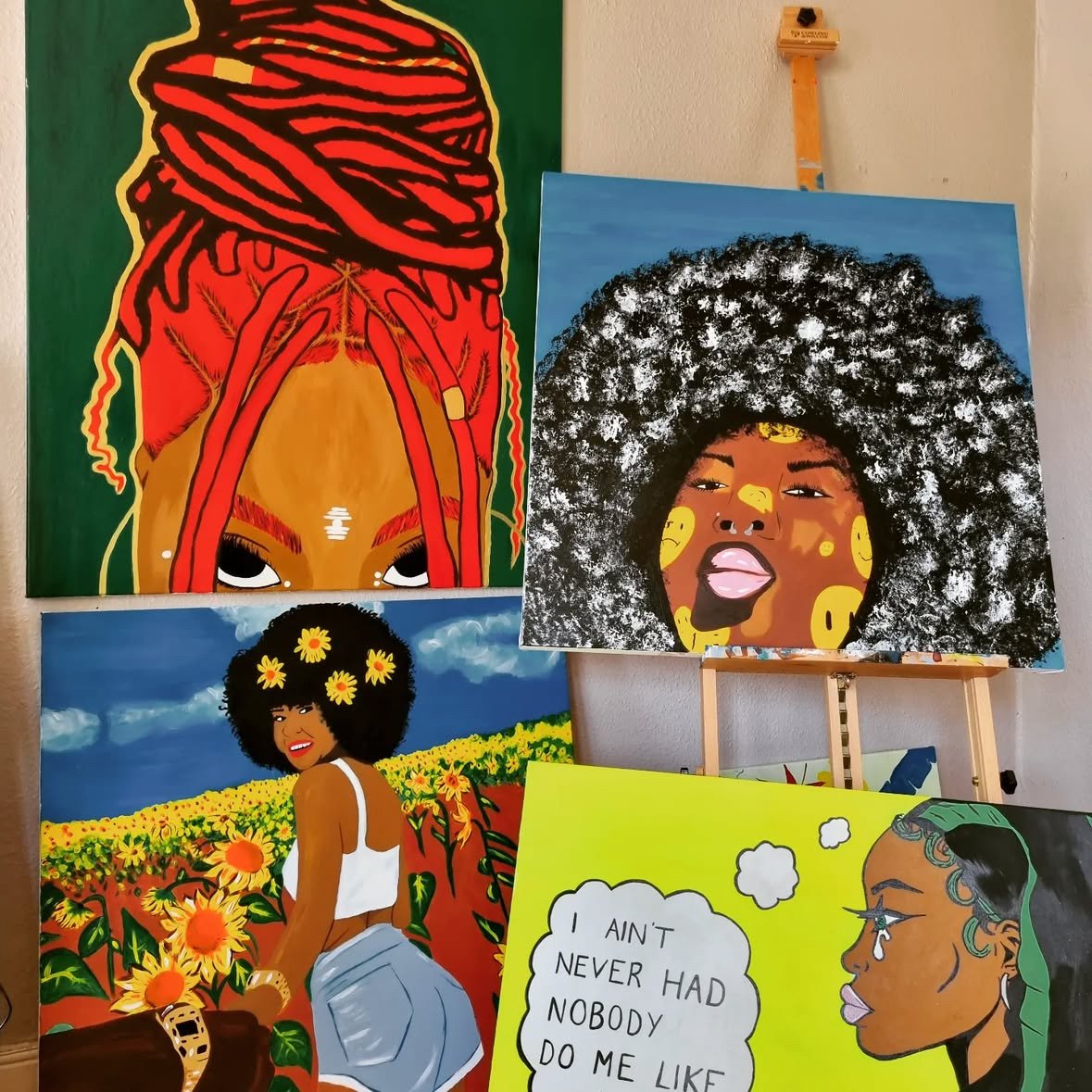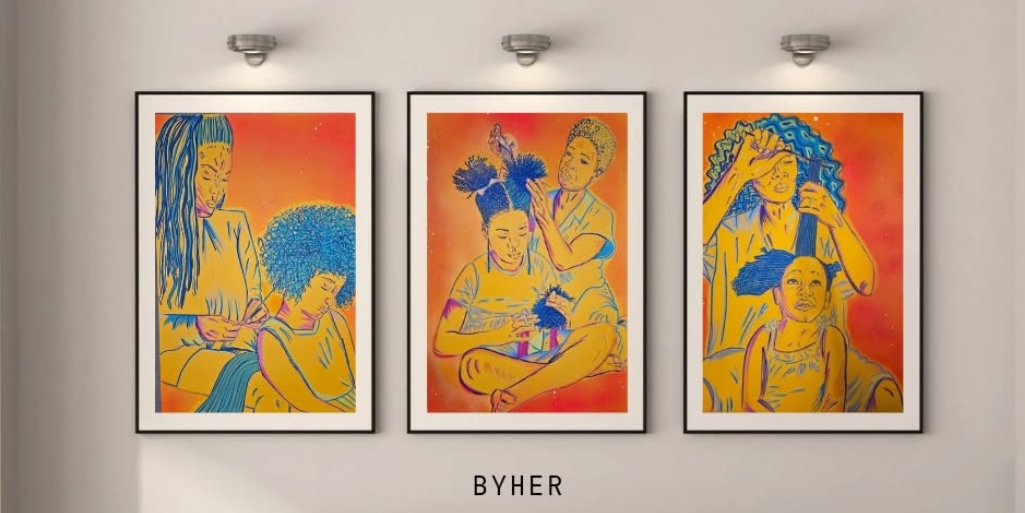Art Therapy: Nina, a Two-Time Cancer Survivor turning her Pain into Beauty by Painting Black Women
Nina’s transformational journey as she navigates homelessness, heartbreak, and illness. From surviving unsafe hostels to single motherhood and a cancer diagnosis, she turns to painting Black women as a way to reclaim her strength and voice. Through art, she not only finds healing but also empowers others to embrace their own struggles with courage and hope.
Born in Swindon, Wiltshire, Nina grows up as the youngest of three sisters in a complex family dynamic
Her father, an ex-military man from Barbados, is strict and militant, while her mother, an Englishwoman, is laddish and outspoken. The contrast between their personalities creates an intense home environment, filled with arguments and strict rules. When Nina is ten, her parents separate. Her father prompts her mother to leave abruptly after having anan affair, and Nina remains with her father.
From a young age, Nina is passed back and forth between her parents, never truly settling in one place.
Her father’s strict and often unyielding nature makes home life tense, while her mother’s unpredictable choices create an unstable environment. She recalls being locked out for missing a curfew, feeling rejeced, reinforcing a deep-seated sense of being unwanted. Nina’s parents rarely communicated, leaving her caught in the middle of their unresolved conflicts. She constantly felt pressured to choose between them, never truly belonging to either side, which deepened her sense of isolation and longing for a stable home.
Nina first starts experiencing sharp pains in her chest, a discomfort that lingers and gradually worsens
She decides to go to the doctor. After multiple tests, she is told that she has lymphoma, a type of blood cancer that has formed as a tumor in her lung.
The biopsy process is grueling. The first attempt is traumatic, leaving her shaken. The second time, doctors decide to go through her chest with a thick needle, extracting tissue piece by piece, centimeter by centimeter. The procedure takes hours, with Nina having to endure multiple scans in between to ensure the needle doesn’t hit anything critical.
When chemotherapy begins, her family initially rallies around her. Her mother travels from Swindon to be with her during the first session, and her boyfriend at the time also offers support. But as the treatments progress and the side effects worsen, their presence starts fading. The most devastating blow comes when her boyfriend leaves her. The moment her hair begins falling out, he walks away, making her feel even more isolated. She loses not just her hair, but also her job, friends, and any illusion of stability she had built.
The chemo is brutal. The chemicals weaken her body, making her sick and exhausted. The loneliness is almost as unbearable as the physical toll. During that time Nina starts painting while in the hospital undergoing treatment. Her first piece is a yin-yang style image of a woman, which she named after her grandmother, "Mama". She hangs this painting in her bedroom, to offer her protection during her treatment. Non the less, each session drains her further, yet she has no choice but to keep showing up, fighting for her survival —not just for herself, but for her child.
Nina eventually meets the father of her child. For the first time in years, she feels supported.
Their relationship is healthy, filled with care and understanding. For a few years, she believes she has found her safe place. But after she gives birth, everything changes. The postnatal period is challenging, not just for her but for her partner as well. The emotional and physical toll of childbirth, sleepless nights, and the weight of new responsibilities become too much. And then, he leaves. She recognizes that her child’s father likely struggled with his own mental health but lacked the resources or knowledge to cope. The absence of adequate support systems for new parents is something she now strongly advocates for, knowing firsthand how fragile that time can be. Nina focuses all her energy on caring for her child. She barely has time to process her own emotions because survival takes priority.
When Nina is 16 she finds herself homeless as moves to London into a hostel
As she is under 18 and wonders why no one from social services steps in to help her. At first, she is placed in a bed and breakfast with families, which isn't too bad. But when she turns 18, she is moved to an adult hostel, and the reality is terrifying. Despite it being an all-women's hostel, grown men are present—men who regularly beat and rape the women living there. The violence is constant. In the room next to hers, a woman is being assaulted. Nina tries to help her multiple times, pulling her away from the abuser, but after a while, the woman keeps letting him back in. Eventually, Nina secures her own flat, a milestone that should bring relief, but instead, it deepens her loneliness.
Nina finally receives the news she has been praying for—she is cancer-free
Determined to reclaim her life, she embraces every moment, going out with friends, enjoying simple pleasures, and rediscovering herself outside of illness. But just as she begins to settle back into normalcy, a new battle emerges.
She develops a fistula, an open wound inside her body that causes excruciating pain. Every movement is agonizing, and the constant discomfort drains her energy. The stress of dealing with this new complication lingers, weighing on her both physically and emotionally. Then, the unimaginable happens—her cancer returns. This time, she must undergo an even more aggressive treatment: a stem cell transplant.
The second round of chemotherapy is unlike anything she has faced before. It takes place during the COVID-19 pandemic, meaning she must endure it alone. Isolated in a hospital room for months, she is unable to see anyone—not even her son. The loneliness is suffocating, but she makes a decision: she will not let fear consume her. Instead of dwelling on medical jargon and the uncertainty of her condition, she focuses on keeping her spirit strong. She paints. She watches 90s sitcoms. She forces herself to laugh, to find joy, to keep going. The worries exist, but she refuses to let them in. Her strength is her refusal to surrender to despair.
During this time, Nina starts drawing Black women hairstyles
At first, she doesn’t realize why, but by the third painting, it hits her—she is painting what she no longer has. Her art becomes a way to process the loss of her hair and her identity. She creates a four-piece hair series of different Black hairstyles, subconsciously healing herself with each brushstroke.
At one point, Nina tells herself that if the cancer is not gone this time, she will give up. But when the final results come in, she is cancer-free once again. Now, three years later, she carries a different mindset. She refuses to let fear rule her life. She does the things she loves without hesitation, knowing that time is precious. Through her art, she continues to celebrate Black women, finding joy in their resilience and beauty, just as she found strength in her own survival.




